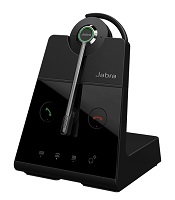To Serve and Protect: Top-Level DECT Security Found in Jabra Engage Headsets
Tags: Jabra, Engage, Engage with Jabra, DECT, Military Standards, Cybercrime
Cybercrime and the theft of personal data is on the rise, and Jabra has risen to the challenge and built its newest DECT wireless headsets, the Engage series, with the wireless connection secured using 256-bit AES encryption, giving a line of defense that goes beyond that of DECT Security Level C.
 Now you may be saying: "WAIT! WHOA! HOLD UP! Wireless headsets can cause a potential security breach?" The average person would not be able to "hack" into any wireless calls without having a pretty specific skill set; however, identity theft is a real concern for businesses handling personal data and sensitive conversations. Customers put their trust in the companies they choose to do business with, and the company must protect its customers with a proactive security culture.
Now you may be saying: "WAIT! WHOA! HOLD UP! Wireless headsets can cause a potential security breach?" The average person would not be able to "hack" into any wireless calls without having a pretty specific skill set; however, identity theft is a real concern for businesses handling personal data and sensitive conversations. Customers put their trust in the companies they choose to do business with, and the company must protect its customers with a proactive security culture.
The Jabra Engage has increased security of the wireless connection between the wireless headset and its base unit, and the rock-solid security is provided in 3 steps, which improve the protection of calls to a category-leading level.
Step 1: Pairing. This first step is a physical bonding of the base unit and headset. Jabra has patented "physical assisted pairing" to increase security. The Jabra assisted pairing method occurs only when the headset is docked in the base unit, and a secret link-key is then formed when the two pair. Wireless connection is secured with patented pairing; authentication between headset and base is established with 128-bit level technology compared to the category-standard 64-bit.
Step 2: Authentication. At the start of a call, encryption is used to set up secure authentication between the Engage headset and its base. A link is established using a secret key-link formed in the pairing (without this, the headset and base unit will not work together). This means that a "non-paired" headset cannot be used with the base unit. The authentication link is also protected by encryption. The better the encryption level, the more secure the established link.
This means that a "non-paired" headset cannot be used with the base unit. The authentication link is also protected by encryption. The better the encryption level, the more secure the established link.
Step 3: Encryption. During calls, the audio signal between base unit and headset transports data, which is secured via encryption. The higher encryption level, the better the protection of data. With Jabra Engage, the encryption link is renewed every minute to make decryption more difficult.
Security algorithms are listed in FIPS 140-2 standards required by the U.S. military and government, and recommended by the National Institute of Standards and Technology for financial institutions who demand the highest degree of security.
In addition, the Engage series enables 3 times as many people to work wirelessly in the same space, which is why Jabra says it was engineered as the world's most powerful professional wireless headset.
To learn more about the Jabra Engage series, contact our team of headset experts today: 1-866-998-9991.
 Now you may be saying: "WAIT! WHOA! HOLD UP! Wireless headsets can cause a potential security breach?" The average person would not be able to "hack" into any wireless calls without having a pretty specific skill set; however, identity theft is a real concern for businesses handling personal data and sensitive conversations. Customers put their trust in the companies they choose to do business with, and the company must protect its customers with a proactive security culture.
Now you may be saying: "WAIT! WHOA! HOLD UP! Wireless headsets can cause a potential security breach?" The average person would not be able to "hack" into any wireless calls without having a pretty specific skill set; however, identity theft is a real concern for businesses handling personal data and sensitive conversations. Customers put their trust in the companies they choose to do business with, and the company must protect its customers with a proactive security culture.The Jabra Engage has increased security of the wireless connection between the wireless headset and its base unit, and the rock-solid security is provided in 3 steps, which improve the protection of calls to a category-leading level.
Step 1: Pairing. This first step is a physical bonding of the base unit and headset. Jabra has patented "physical assisted pairing" to increase security. The Jabra assisted pairing method occurs only when the headset is docked in the base unit, and a secret link-key is then formed when the two pair. Wireless connection is secured with patented pairing; authentication between headset and base is established with 128-bit level technology compared to the category-standard 64-bit.
Step 2: Authentication. At the start of a call, encryption is used to set up secure authentication between the Engage headset and its base. A link is established using a secret key-link formed in the pairing (without this, the headset and base unit will not work together).
 This means that a "non-paired" headset cannot be used with the base unit. The authentication link is also protected by encryption. The better the encryption level, the more secure the established link.
This means that a "non-paired" headset cannot be used with the base unit. The authentication link is also protected by encryption. The better the encryption level, the more secure the established link.Step 3: Encryption. During calls, the audio signal between base unit and headset transports data, which is secured via encryption. The higher encryption level, the better the protection of data. With Jabra Engage, the encryption link is renewed every minute to make decryption more difficult.
Security algorithms are listed in FIPS 140-2 standards required by the U.S. military and government, and recommended by the National Institute of Standards and Technology for financial institutions who demand the highest degree of security.
In addition, the Engage series enables 3 times as many people to work wirelessly in the same space, which is why Jabra says it was engineered as the world's most powerful professional wireless headset.
To learn more about the Jabra Engage series, contact our team of headset experts today: 1-866-998-9991.

